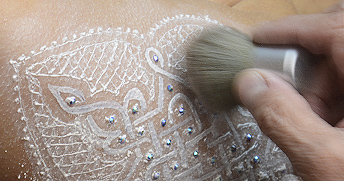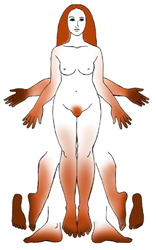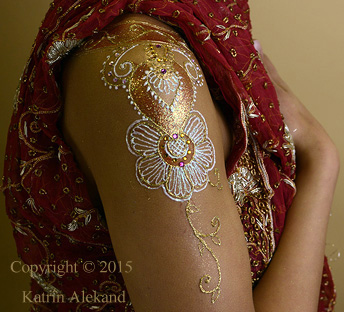
|
'White
henna' refers to a body adhesive created for the attachment of surgical
appliances to skin and for make up artists to apply cosmetic appliances (such as elf ears) to skin. Becoming Moonlight® Gilding Paste, (often called 'white henna'), is a body adhesive which has been specifically adapted for henna body
art: it is a white paste which can be applied with a cone, and sealed with glitter or gilding powder.
- These body adhesives contain water, acrylic
emulsion, glyceryl, guar gum, sorbitol, titanium dioxide, and a trace
(less than 1%) of benzyl alcohol.
- When
you dust glitter or gilding powder over the surface of ''white henna'
you can create any color you desire: the colors of glitter or gilding
powder stick to and seal the surface of the adhesive.
'White henna' is NOT:
- colorless henna
- skin bleach
- henna or any product for hair called 'white henna'
|
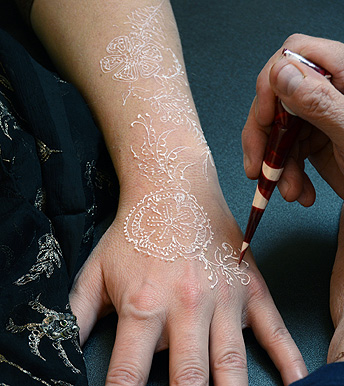 |
How does 'white
henna' work?
- Apply 'white henna' to skin as you would apply henna.
- When the wet, sticky paste becomes firm, apply gilding powder or glitter generously over the surface of the 'white henna'.
- The powder and glitter will stick to and seal the 'white henna' paste.
- Brush away the excess gilding powder or glitter.
- The paste will no longer be sticky, and is now waterproof and durable.
- The 'white henna' will stay on the skin from three to ten days depending on how well the person takes care of the work.
|
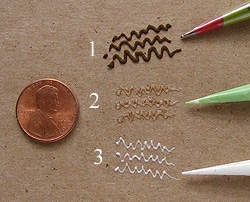
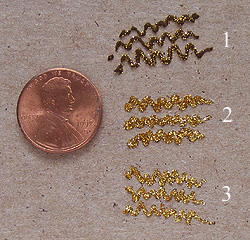
|
What are the varous
'white hennas' and how are they different from henna?
- At left, #1 is henna, #2 is Pros-Aide Cream Adhesive, and #3 is Becoming Moonlight® Gilding Paste.
- Becoming
Moonlight® Gilding Paste is adapted specifically for henna artists.
This paste retains some color when dry, so you can see what you're
doing. This paste does not dry flat and it keeps the raised appearance of a henna
line. This paste is slightly thicker, closer to what a henna artist is used
to working with.
- Pros-Aide Liquid Adhesive: a thin liquid which can be applied with a brush and dries flat and transparent
- Pros-Aide
Cream Adhesive: a thicker version of Pros-Aide Liquid Adhesive which
can be applied with a cone and which dries flat and transparent.
- You
will get better results if you use a thinner line with the 'white
henna' pastes than with henna. Thinner lines of 'white henna' dry
faster.
- Thick lines in henna make a darker stain. Thick lines in 'white henna' dry very slowly.
- Glitter and gilding powder stick readily to 'white henna' paste, and form the surface of the pattern.
|
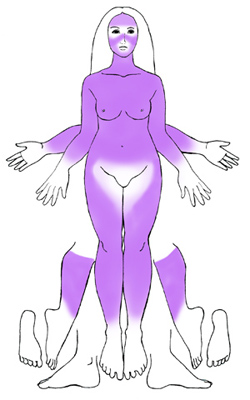 |
Where does 'white
henna' work best?
- Plan your 'white henna' to take advantage of the violet areas in the drawing at the left.
- Avoid hairy, sweatty, or oily areas.
- Avoid places which are rubbed by use or by clothing.
- 'White henna' works in many of the areas where 'natural henna' is not particularly successful.
|
If 'white henna' is
not natural, is it safe?
- These
adhesives that are used as 'white henna' were originally developed for
physicians to attach life-saving medical prosthetics to a person's
skin. These adhesives are also used by professional makeup artists to
attach prosthetics for
special effects.
- The 'white henna' pastes discussed HERE: http://hennapage.com/henna/white_henna/
are the worldwide industry standard for use in the professional medical
prosthetic and special effects make-up industries, and have been used
for over thirty years.
- These adhesive products do not contain latex.
- Do not apply these pastes to a person who has an allergy to medical adhesives or Band-aids.
|
If I have the ingredients, why
can't I mix my own 'white henna'?
- If
you have a degree in polymer science and a laboratory set up, go right
ahead. The molecules that make up these adhesives are very complex
structures, potentially cotaining millions of monomers, and the pastes
absolutely love to clollapse into a lumpy, sticky, useless mess.
- If
you try to fiddle with these adhesives to make them thicker, thinner,
or colorful, the molecules are apt to react badly and the paste can
collapse into a mess.
- Seriously, just follow the instructions here: http://hennapage.com/henna/white_henna/
The HennaPage artists who worked on developing Becoming Moonlight®
'white henna' since 2012 have largely figured out how to do this.
|
How long will 'white henna' last?
- So far, these body adhesive pastes seem to last a year in a jar and at least six months in a cone
- Keep your paste at room temperature.
- Do not freeze!
| Is "white henna" better than real henna?
- No, it's just a different media which has been adapted to the needs of henna artists.
|

So, what is Becoming Moonlight® Gilding Paste? - We
asked the chemist who invented Pros-Aide Liquid Adhesive and Pros-Aide
Cream Adhesive to develop a variant especially for artists. Artists
needed the paste to be thicker, less transparent when dry, and to stay
raised on the skin.
- The
chemist looked at the work the HennaPage artists had done, thought it
looked great, and was excited that his invention for medicine could
also be used for art. He created Becoming Moonlight® gilding
paste and mehandi.com has exclusive rights to this paste.
- Becoming Moonlight® is absolutely different from the other pastes.
- Pros-Aide Liquid Adhesive and Pros-Aide
Cream Adhesive can be used by any artist who can work around their limitations.
| What is Becoming Moonlight®?
Becoming
Moonlight® is a coordinated group of waterproof, durable, skin-safe
body art media developed for henna artists working with hennapage.com.
These materials and techniques allow artists to extend body art with
white, silver, gold, work, and endless colors.
Henna is not the
perfect body art medium for every situation; Becoming Moonlight® was
created to extend body art where henna falls short. Henna is best for
hands, feet, lower arms and legs. The best areas for Becoming
Moonlight® are generally the reverse of henna: shoulders, chests, legs
and arms. Becoming Moonlight® can be integrated beautifully with henna.
Henna
works well for people who can be patient, who can keep the henna on
their skin for several hours before removal. Henna has a narrow range
of colors, and gradually fades. Other attempts to extend henna’s color
range and shorten the stain time involve the addition of dangerous
chemicals that have caused serious injuries for both artists and
patrons. Becoming Moonlight® is ready to show off when the painting is
done: there is no waiting for the paste to stain or for the color to
darken, and the potential colors are endless.
Henna has one
narrow range of color based on the oxidation of the lawsone, from
orange to very dark sepia. The color fades gradually over three weeks.
Becoming Moonlight® body art media has an unlimited range of color and
texture. Though Becoming Moonlight® can last up to two weeks depending
on placement and care, you can remove it quickly, completely, and
easily.
Learn
to ornament and extend your body art with Becoming Moonlight®!
See what other artists have done! You can do it too! |


